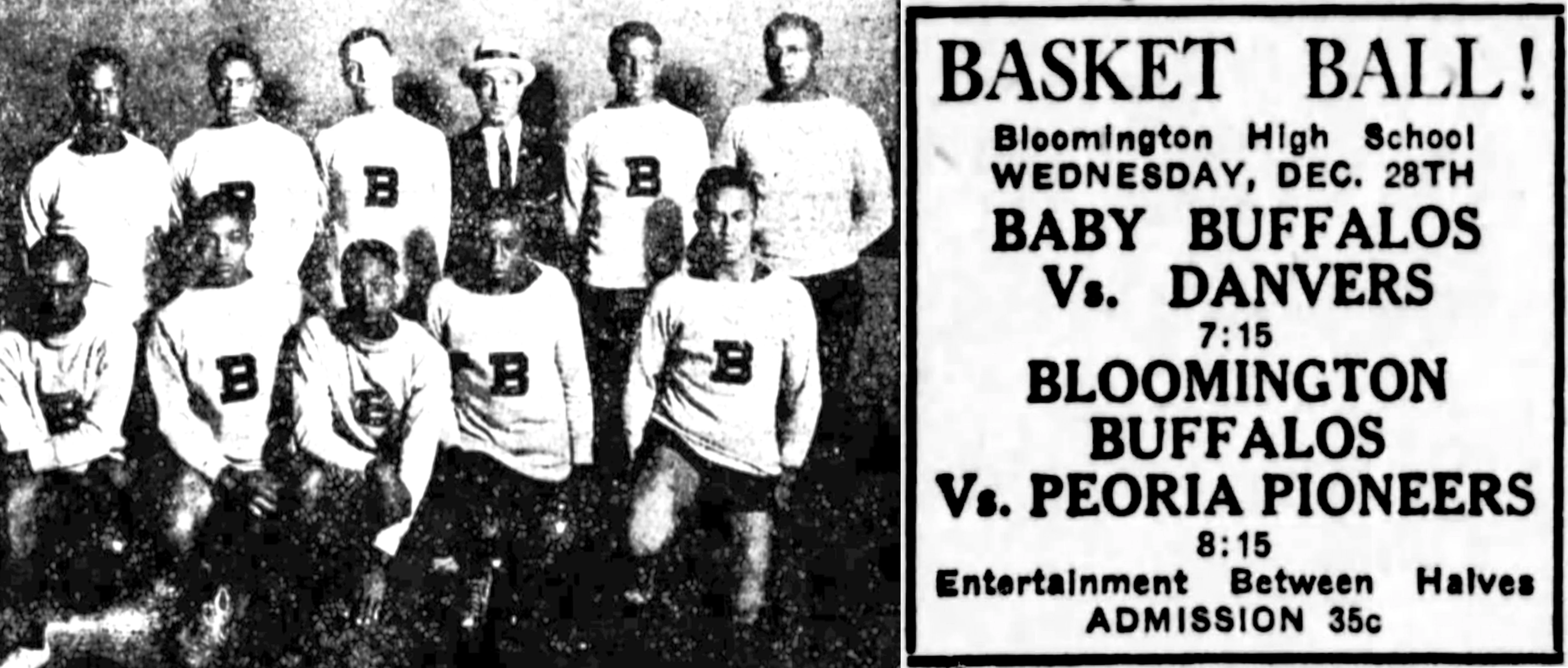In late October 1921, the Bloomington Buffaloes, a “colored” basketball team, defeated a rival club called the Independents by the score of 48 to 36. “This makes the eighth straight win for the Buffaloes over some of Bloomington’s crack white teams,” reported The Pantagraph. “The Buffaloes want a heavy schedule and are willing to book games with all comers.”
During the first half of the 1920s, the Buffaloes were one of the stronger independent basketball teams in Central Illinois. The club, which also competed in loosely organized leagues, traveled throughout Central Illinois to play white and black teams wherever they could—from the smaller towns to the bigger cities. The Buffaloes tipped off against rivals from Bellflower, Cropsey, Delavan, Heyworth, Hudson, Lexington, Morton, Peoria, Stanford, Strawn, Wapella, Waynesville and many other villages, town and cities.
Home games were usually played at a public school gymnasium in Bloomington—either at the high school or one of the elementary / secondary schools, such as Irving. It’s possible, but unlikely, the “Buffs” competed against racially integrated teams.
Edward Bynum, the Buffaloes’ manager, was a veteran of World War I. Several players were veterans as well, including Paul E. Turlington. These black “cagers” (as basketball players were once known) had served in the Eighth Regiment, Illinois National Guard, which during the war was reorganized as the 370th Infantry, becoming in the process the highly decorated “Black Devils” regiment.
At one time or another, the Buffaloes lineup included Eugene Bynum, Edward’s brother, “Speed” Walker, a Bloomington High School standout athlete, Virgil Dean, Walter Gaines, Rozell Samuels, Harry Woods and others. Several Buffaloes also made a name for themselves on the diamond with the Bloomington Colored Giants, an African-American baseball team active around the same time. There were other all-black Twin City basketball teams of the era, including the Bloomington Vandals, though they enjoyed nothing like the organizational stability and hardwood success of the Buffalos.
Although it’s not known exactly why the local team carried the nickname “Buffaloes,” in all likelihood it honored the African-American 10th Cavalry Regiment of Wild West fame. Cavalrymen in this decorated regiment were known as Buffalo Soldiers.
The Bloomington Buffaloes operated as a social-athletic club, with several leaders of the local African-American community serving as officers. The team’s treasurer (at least during the 1922-23 season) was Dr. Eugene Covington, a well-respected Bloomington physician. For most games spectators were charged admission, with proceeds likely covering various expenses, from the visiting team’s travel to renting the gymnasium.
A deteriorating racial climate—on both the national and local levels—marked the decade of the 1920s. In the Twin Cities, African-Americans faced not only segregated beaches at Miller Park, a despicable practice dating to 1908, but increasing Jim Crow restrictions when it came to private and public accommodations. By the end of the decade, for example, blacks could not eat in downtown Bloomington restaurants or stay in downtown hotels.
Although these written and unwritten rules of racial segregation treated local African Americans as second-class citizens, the Buffaloes—at least when they stepped onto the basketball court— were able to compete on an equal basis with all comers, black and white.
During the 1921-1922 season, Coach Bynum added Richard Tate to the Buffaloes roster. Tate, a stellar halfback for the Bloomington High School football team, would go on play baseball (1927, 1935) and football (1926-27) for Illinois State Normal University. He was inducted into the Illinois State Athletics Hall of Fame in 1972. In the 1922-23 season, the team “imported” several out-of-towners, including Henry Hatchett of Joliet and Mack (or “Mace”) Willis from Danville, to strengthen the homegrown lineup.
From all available evidence, it appears the Buffaloes faced little overtly hostile racial animus when visiting small rural communities to play all-white teams in front of all-white crowds. One of the few controversies occurred in December 1922 when the Buffaloes refused to travel to San Jose, Ill., to play the local Triple A.’s. After Bloomington beat visiting San Jose on Dec. 19, the Buffaloes cancelled the scheduled return game at the San Jose Methodist Episcopal Church gymnasium. “Word came to the Buffaloes,” reported The Pantagraph, “that the San Jose boys planned to have the Buffaloes beaten up and then chased out of town, regardless of the outcome of the game.”
The San Jose team and its boosters cried foul. “No visiting team at San Jose has received anything but the most courteous treatment from the players and public,” declared C.E. Curtis on behalf of San Jose. Curtis noted that “colored” baseball teams from Bloomington and Peoria had played in San Jose without incident.
On Feb. 15, 1923, the Buffaloes beat the Vandals, an African-American club from Peoria. With that win, according to The Pantagraph, “Bloomington’s colored boys” now stood atop the standings of an African-American basketball league. Little is known of this league, though it likely operated on an informal basis and, in addition to Bloomington and Peoria, may have included teams from Decatur, Lincoln, Springfield and elsewhere.
Lopsided losses were not uncommon, and depending on the particular lineup on a given day, the Buffaloes could be on the winning or losing end of such contests. To cite one representative example, on Dec. 26, 1924, the Buffaloes trounced Hudson’s “Independent Five” 42-6.
Near the end of the 1923-24 season, Feb. 29, 1924, the Buffaloes met L.R. Baugh’s Decorators for what was called the “independent championship” of Bloomington. The Buffaloes came into the contest with a stellar 31-3 record, while the Decorators, sponsored by Lucien R. Baugh’s interior decorating business, stood at an equally impressive 19-1. The defensive-minded game—said to be “fast and furious from start to finish”—ended with the Decorators besting the Buffaloes 17-10.
After completion of this successful season, the Buffaloes were mostly inactive until the club reappeared on the local sports scene in late 1930. At this time their schedule included games as far away as Evanston, and their best player was Harry Caldwell, who lettered in basketball at ISNU.

